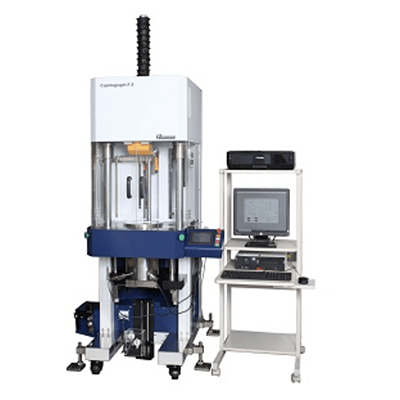What Is a Capillary Rheometer?

A Capillary Rheometer is a measurement device used to evaluate shear stress and viscosity of flowing materials.
Capable of measuring samples heated to high temperatures, capillary rheometers are used to evaluate the physical properties of materials such as plastics, which are solid at room temperature. Capillary Rheometers can evaluate rheological properties related to the viscosity of a material and its flowability when pressure and temperature are applied.
Rheological properties are those related to the reaction of a sample when an external force is applied to it. A solid sample, such as plastic, is heated in the apparatus until it becomes liquid. The heated sample is fed into a thin tube called a capillary and extruded at various speeds.
A capillary rheometer measures the melt viscosity relative to the extrusion speed. Note that a capillary is a capillary tube, and it is called a capillary rheometer because it evaluates physical properties by extruding a narrow passage.
Capillary Rheometer Applications
Capillary Rheometers are used to process thermoplastic materials and to set discharge conditions for injection molding. In general, processing plastics requires the application of high pressure at high temperatures.
Some materials exhibit a non-linear change in viscosity (sudden decrease or sudden increase in viscosity) with respect to the applied external force, a property known as non-Newtonian liquid. Therefore, the viscosity of a sample with respect to pressure and temperature must be investigated to design optimal processing and dispensing conditions. Capillary Rheometers are used to set optimum conditions for manufacturing processes for polymers and composite materials such as plastics.
Principle of Capillary Rheometer
The principle of Capillary Rheometer is just like measuring the force and speed of pushing a liquid out of a syringe. A thermoplastic material is heated to make it flowable and then extruded from a cylinder into a narrow passage called a capillary die.
The shear stress and viscosity of the material at the test temperature are determined from the pressure at which the sample is extruded and the speed at which it is extruded. Depending on the device, die swell measurements, melt audibility (melt tension), and extensional viscosity measurements are also possible.
Capillary Rheometer Structure
Capillary Rheometers have a narrow passage called a capillary die at one end of the cylinder and a plunger at the other end, which pushes out a heated sample. The structure of a capillary rheometer consists of a pressure gauge to measure the pressure inside the cylinder when the sample is pushed out and a plunger to measure the speed at which the plunger moves to push the sample out.
Capillary Rheometer Features
1. Effective for Rheological Evaluation
Capillary Rheometers are characterized by their ability to measure at high temperatures and high forces (high shear). Although the upper limit differs depending on the device, it can be heated up to 400°C or higher, making it effective for evaluating the viscosity of melted plastics. Shear force is also extremely high, up to 1,000,000/second, making it possible to examine the flowability of a sample when a large force is applied. Since extremely high forces are often applied during plastic processing at the time of discharge, it is important to investigate the behavior of samples when such high shear is applied.
2. Effective for Evaluation of Products Subjected to High Shear
In addition to plastic materials, capillary rheometers are also used to evaluate food products such as ketchup and mayonnaise, as well as gel cosmetics, which are subject to high shear when extruded from their containers. Capillary Rheometers can be used at room temperature, and the wide range of shear forces applied to samples and the high precision of the instrument allow for the investigation of the ejection behavior of flowable foods and cosmetics from their containers.
Capillary Rheometers can also be used to measure viscosity at different shear rates, so that in actual measurements, samples are evaluated by drawing a curve of melt viscosity versus shear rate.